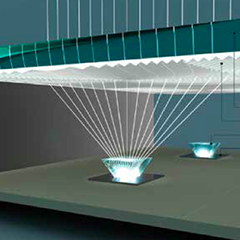Advances are being made in the field of concentrating optical units – and silicones are leading the charge.
Inexpensive optics can cut down on precious solar-cell surface area – this is the basic idea behind photovoltaic concentrators. Many manufacturers use concentrating optics composed of Fresnel lenses to achieve this aim. The lens system is increasingly being made from a highly transparent silicone applied directly to the inside face of the glass front panel. Concentrator modules are noted for their excellent long-term stability.
Technological advances have paved the way for the continuous reduction in solar electricity production costs. One way to increase efficiency is to use photovoltaic concentrators – which focus the sun’s rays onto specially designed solar cells. More precisely, these concentrators have optical elements which focus the sun’s rays directly onto small, highly efficient cells (monocrystalline silicon, compound semiconductor) or stacks of cells comprising several semiconductor materials one on top of the other. Concentrating the light onto the cells cuts down on solar-cell surface area.
The industry itself has created the conditions that will allow concentrator technology to become established: it has succeeded in taking highly efficient solar cells from the laboratory to series-production scale. The sun-tracking systems are accurate and reliable, and several highly efficient methods for the concentrator optics have been developed and tested. What’s more, great strides have been made in module structure and longevity over recent years.
The most widespread among the highly concentrating optical units are systems composed of Fresnel lenses. Advances have recently been made in the guise of flat sandwich systems comprising a system of silicone Fresnel lenses on a glass panel covering the front of the module.
Highly Concentrating Photovoltaics with Fresnel Lens Systems
Refraction and reflection of light are used almost exclusively by the PV industry to concentrate the sunlight. There are many different ways to accomplish this, which is why there are so many different designs. The high concentration (geometric concentration factors in excess of 200) is obtained with curved mirrors, Cassegrain mirror systems, as well as curved lens and Fresnel lens systems.
The basic features of many types of modern optical concentrators were developed and tested back in the late 1970s, when the nascent concentrator technology was used for terrestrial applications.



























